
Parasites and Their Treatment Pages: 1 2 3 4 5 Next>>
Parasites and Their Treatment During the Golden Age of Piracy, Page 2
Biting Flies and Mosquitoes
"[1705] Whilst we were at this Island of Amboyna
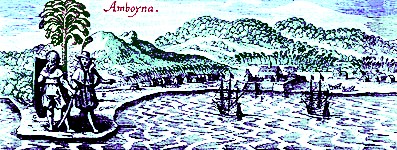
Amboyna - Ambon Island, Indonesia (1655)
[Ambon Island, Indonesia], we were so much troubled with Moskitoes, (which are a sort of Gnats,) that every Night we were forced to put our selves in a Bag, before we could go to sleep; for otherwise these Creatures would so bite us, that there was no sleeping: And whereever they bite, they commonly raised a red Blister, almost as broad as a Silver-penny: This would itch very much, and many could not forbear scratching themselves so, as to cause Inflammations, which sometimes are the cause of the loss of a Limb." (William Funnell, A Voyage Round the World, p. 270)
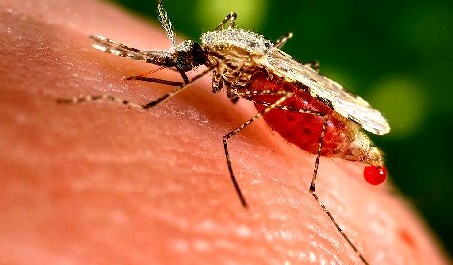
Photo: Jim Gathany - Engorged Female Mosquito Excreting Excess Blood
Mosquitoes and biting flies were (and still are) an ever-present problem in warm climates. While talking about Panama in his 1699 book, surgeon Lionel Wafer commented "this Country is not so pester’d with that uneasie Vermin, as many other of the warm Countries are"1, drawing attention to the fact that such pests were prevalent in this area at that time.
Merchant slaver captain Thomas Phillips says that the African Company's 'factory' - a sort of fortified building where the slaves were gathered and processed - in Whidaw (modern Ouidah, Benin on the African content) that it was
a most wretched place to live in, by reason of the swamps adjacent, whence proceed noisome stinks, and vast swarms of little flies, call’d musketoes, which are so intolerably troublesome, that if one does not take opium, laudanum, or some other soporifick, ’tis imposible to get any sleep in the night; and that one I lay there was the most uneasy that I ever felt, for I had not lain down above an hour in the factor’s bed, but I was so vex’d and tormented by those little malicious animals, that I was forced to get up again, and dress myself, put gloves on my hands, and tie a handkerchief over my face till day-light, which notwithstanding these troublesome devils would sting thro; and the place so stung would be much inflam'd, and rife into a knob, much provoking the exercise of a man’s nails...2
Philip Ashton, one time prisoner of pirate Edward Low, gave a vivid account of these pests in the Caribbean during the account of his capture by and eventual escape from Low.
The Islands are also greatly infested with vexatious Insects, especially the Musketto, and a sort of small Black Fly, (something like a Gnat) more troublesome than the Musketto; so that if one had never so many of the comforts of Life about him, these Insects would render his Living here very burthensome to him; unless he retired to a small Key, destitute of Woods and Brush, where the Wind disperses the Vermin.3
The 'small Black Fly'
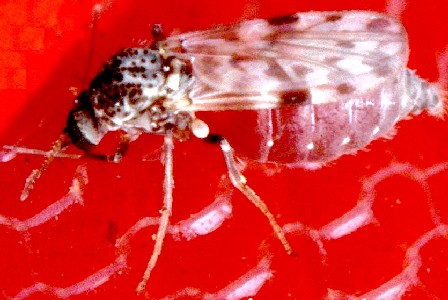
Photo: Scott Bauer - Female Biting Midge
which Ashton is talking about is likely the biting midge (scientifically referred to as Ceratopogonidaes, often colloquially called no-see-ums). The more virulent species are often found in sandy beach and mountainous areas such as exist all over the Caribbean.
Like mosquitoes, the female midges are usually adapted to suck blood from a host.4 While biting midges feed upon the blood, the most important function of blood meals for female mosquitoes is to obtain proteins as materials for egg production. However, the mosquito can also obtain energy and concentrated nutrients from the blood.5
Biting female midges have elongated mandibles in their proboscis, which contain cutting teeth adapted for blood-sucking.6 Female mosquitoes have a similar arrangement. The visible part of the mosquito's 'stinger' is actually called the labium, which is a sheath enclosing the rest of the mouthparts. The mouthparts include mandibles and maxillae, which are used for piercing the skin.
The mandibles are pointed, while the maxillae end in flat, toothed "blades". To force these into the skin, the mosquito moves its head backwards and forwards. On one movement, the maxillae are moved as far forward as possible. On the opposite movement, the mandibles are pushed deeper into the skin by levering against the maxillae. The maxillae do not slip back because the toothed blades grip the skin.7
The bites of both mosquitoes and midges result in itchy red welts that persist for about a week.
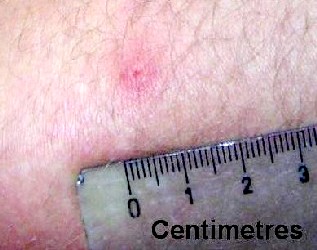
Photo: Wiki User Mortsggah - A Midge Bite
The discomfort felt by host arises from a localized allergic reaction to the proteins in their saliva, which contains an anticoagulant8.
Like lice, both midges and mosquitoes can carry diseases. Mosquitoes are primarily responsible for the transmission of malaria, dengue and yellow fever.9 However, this fact was not recognized during the golden age of piracy, so explanations of these diseases and their treatment are left to other articles.
Golden age of piracy period surgeons give no advice on treating mosquito or midge bites, probably because their effects were so minor and limited. (Funnell's assertion in the opening quote of this section that mosquito bites could result in amputation are a bit fantastic. This might have occurred in limited cases, most likely due to the patient opening the skin through excessive scratching and then allowing it to become and remain infected. This could lead to gangrene and even eventual amputation, but it would require the patient to completely ignore his wound when it should clearly needed treatment.)
Merchant slaver captain Phillips suggested a treatment for the mosquito bites. "The best means I could find to allay the inflammation, was to rub the parts affected with lime-juice, or vinegar, which tho’ for the present it produced a smart, the ease it gave, in a short time, made abundant recompence"10.
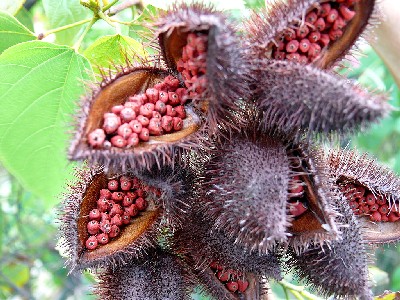
Photo: Arria Berlli - Bixa Orellana (Roucou) Seed Pods
Attempts were also made to keep the stinging and biting insects away, such as Funnell's sleeping bags. Apothecary Robert James suggested burning the leaves of flea bane "to drive away Gnats, Fleas and other troublesome Insects"11. Colorful French clergyman and student of life Jean-Baptiste Labat reveals how the Carib Indians dealt with the problem, although it was probably not used by most Europeans, except in desperate circumstances. Labat explained,
they paint themselves every day with a mixture of racou [the shrub Bixa orellana] and castor oil which makes them look like boiled lobsters. Besides the pleasure the colour gives them, the painting serves two useful purposes. In the first place it prevents the sun blistering their skin, and in the second place, gnats and mosquitoes dislike the smell of it. Without this paint, indeed, the Indians would be tormented by the bites of these insects.12
1 Lionel Wafer, A New Voyage and Description of the Isthmus of America, p. 94; 2 Thomas Phillips, 'A Journal of a Voyage Made in the Hannibal', A Collection of Voyages and Travels, Vol. VI, Awnsham Churchill. ed., p.215; 3 Philip Ashton, cited in George Francis Dow and John Henry Edmonds, The Pirates of the New England Coast 1630-1730, p. 248; 4 Ceratopogonidae, Wikipedia, gathered 1/7/15; 5 Mosquito, Wikipedia, gathered 1/7/15; 6 Featured Creatures: Biting midges, University of Florida Etymology and Nematology, gathered 1/7/15; 7 Mosquito, Wikipedia, gathered 1/7/15; 8 Ceratopogonidae, & Mosquito, Wikipedia, gathered 1/7/15; 9 Mosquito-Borne Diseases, mosquito.org, gathered 1/7/15; 10 Thomas Phillips, p. 215; 11 Robert James, Pharmacopœia universalis, p. 299; 12 Pere Jean-Baptiste Labat, The Memoirs of Pére Labat 1693-1705, p. 70-1
Biting Flies and Mosquitoes - Devices for Punishment and Torture
These insects also had the rather curious distinction of being used as instruments of punishment. William Dampier reported that a captain who had robbed another captain was punished in Mindanao in 1686, "according to their own Custom, which I did never see but at this time."
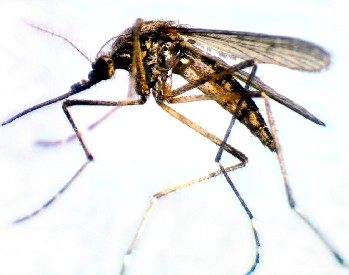
Photo: Wiki user Ivtorov - Culex Pipiens - Common Mosquito
He was stript stark naked in the Morning at Sun-rising, and bound to a Post, so that he could not stir Hand nor Foot, but as he was mov’d; and was placed with his Face Eastward against the Sun. In the Afternoon they turn’d his Face towards the West, that the Sun might still be in his Face; and thus he stood all Day, parcht in the Sun (which shines here excessively hot) and tormented with the Mosikito’s or Gnats: After this the General would have killed him, if Captain Swan had consented to it. I did never see any put to Death; but I believe they are barbarous enough in it. The General told us himself that he put two Men to Death in a Town when some of us were with him; but I heard not the manner of it. Their common way of punishing is to strip them in this manner, and place them in the Sun; but sometimes they lay them flat on their Backs on the Sand, which is very hot; where they remain a whole Day in the scorching Sun, with the Moskito’s biting them all the time.1
Scaphism describes a method of torture/execution that relies on a similar technique. The victim

Artist: Willem Van de Velde the elder
Zeeland Man-of-War & Row Boat (late_17th c.)
is tied inside of a boat and forced to eat milk and honey, causing diarrhea. The sweet milk and honey would attract insects who bit them and bred on their exposed skin and the feces in the boat.2
Although this method is regarded as an ancient torture method, it is not discussed in any period sources. However, surgeon/navigator Aaron Smith described an instance of something similar to it in 1822 when a crew member whom the captain felt was plotting mutiny was to be punished. The man was tied "stripped and exposed, naked, wounded and bleeding as he was"3 in a boat where he was "pinioned and lashed in the stern"4 and rowed about the area, being exposed to the sun and insects. Smith describes it in some detail,
Prior to our leaving the schooner, the thermometer was above ninety degrees in the shade, and the poor wretch was now exposed naked to the full heat of the sun. In this state we took him to the channel, one side of which was bordered by swamps full of mangrove trees, and swarming with the venomous insects before mentioned.
We had scarcely been half an hour in this place when the miserable victim was distracted with pain; his body began to swell, and he appeared one complete blister from head to foot. Often in the agony of his torments did he implore them to end his existence and release him from his misery; but the inhuman wretches only imitated his cries, and mocked and laughed at him. In a very short time, from the effects of the solar heat and the stings of the mosquitoes and sandflies, his face had become so swollen that not a feature was distinguishable; his voice began to fail, & his articulation was no longer distinct.5
Amazingly, the man survived this treatment and was eventually killed by drowning according to Smith.
1 William Dampier, Memoirs of a Buccaneer, Dampier’s New Voyage Round the World -1697-, p. 243; 2 Scaphism, wikipedia, gathered 1/13/15; 3 Aaron Roberts, The Atrocities of the Pirates, p. 72; 4 Roberts, p. 74; 5 Roberts, p. 74;
Intestinal Worms
"Where general hygiene is poor, intestinal parasites usually abound. ...They were an unrelenting scourge in the eighteenth century." (Guy Williams, The Age of Agony, p. 60)
Worms appear to have been a common problem among sailors.

Clonorchis Sinensis - Chinese Liver Fluke Which Lives on Bile in the Human Liver
Sea surgeon John Moyle said that "I have known when men at Sea have been very much troubled with the Worms"1, further noting "how lamentably men are troubled with these offensive Vermin, sometimes in the Bowels, sometimes in the Liver, and sometimes in the Stomach"2.
One cause of intestinal worms was suggested to be food. This is probably because, without effective refrigeration, foodstuffs tended to become worm ridden, which may have led them to forge the link between food and worms. When commenting on the part of his perverting voyage near Brazil, Captain Woodes Rogers noted that "The chief Distemper of the Natives is the
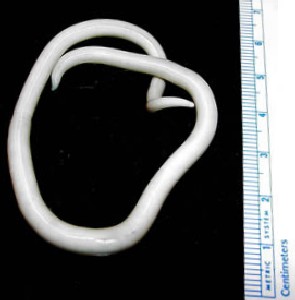
Photo: CDC
Ascaris Lumbricoides or Giant Roundworm
1/6 of the World's Population are Estimated to
Be Infected, Particularly in Tropical & Subtropical Areas
Worms beforemention’d", which he suggested was due to their eating meat raw.3 John Moyle listed several things he knew to cause worms including men "sometime[s] eating of much raw Fruit, or other vitious [vicious] Diet; that makes fit matter for Worms to Generate."4 Apothecary Nicholas Culpeper noted that the herb basil was claimed to have some health-giving properties by other physicians, but "the truth is, it will quickly putrifie, and breed worms."5
Food can definitely be a source of worms. Pork had a tendency to deteriorate quickly, carrying a number of communicable diseases. Modern author Emily Cockayne found that, "Between 1648 and 1687 there were over thirty cases of fines [in London] for selling measled swine, with a peak of offences in the 1670s and 1680s. Measled pork was the meat from a pig infested with tapeworms or bladderworms."6 It is notable that pork was a common food shipboard when it could be gotten.
Sea surgeon John Atkins had a slightly different take, suggesting that intestinal worms generated themselves within the body with "the Colour, Shape, and Magnitude of such Worms, being clearly owing to the Parts [of
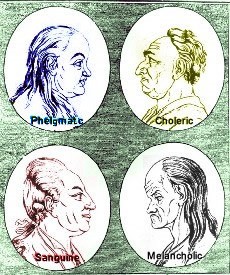
The Four Humoral Temperaments, From
Physiognomische Fagmente,
by JC Lavaters (1792)
the body] they breed in, and the Matter they are bred from"7. Atkins did say that this spontaneous generation of intestinal
worms required "crude putrefying Food, meeting with a weak Concoction, and Deficiency of Bile"8. Apothecary and physician Jean de Renou took this concept to extremes, explaining that a worm "springs from all altered and putrid matter, stones, bones, wood, fruit, cheese, flesh; and all things found at first to turn into worms ...some are procreated of salt: they are also generated in Animals daily... [and are] generated in the intestines, and other parts of mans body
"9.
While John Moyle attributed worms to foods, he did note that "some people have certain habit and humour fit to breed Worms, especially at some times."10 Part of humor theory suggests that people were divided into four temperaments, each represented by a different body type and natural disposition. Unfortunately, Moyle doesn't go into detail as to which humoral types were more likely to breed worms.
Of course humor theory had another part, one more relevant to medicines: that of the fluid humors in the body. it wouldn't be a proper period explanation of illness if one of the authors didn't take these viscous humors into account. Jean de Renou does so, explaining that worms occurred in animals which had a lot "putrid humours; for there worms are generated, where putretude resides: for, Corruption is their Mother."11
1 John Moyle, Abstractum Chirurgæ Marinæ, p. 112; 2 John Moyle, The Sea Chirurgeon, p. 253; 3 Woodes Rogers, A Cruising Voyage Round the World, p. 61; 4 Moyle, p. 254; 5 Nicholas Culpeper, Pharmacopœia Londinesis, p. 33; 6 Emily Cockayne, Hubbub: Filth, Noise, and Stench in England, 1600-1770, p. 95; 7 John Atkins, The Navy Surgeon, p. 372; 8 Atkins, p. 372-3; 9 Jean de Renou, A Medicinal Dispensatory, p. 468-9; 10 Moyle, Sea Chirurgeon, p. 253; 11 de Renou, p. 269

